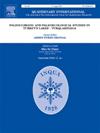Phytolith production in non-woody plants from the Atlantic Forest on islands of the Paraná River, Brazil
IF 1.8
3区 地球科学
Q3 GEOGRAPHY, PHYSICAL
引用次数: 0
Abstract
Phytolith reference collections of modern plants (RC) are essential tools for understanding and disseminating variations in phytolith production both within and among plant families, thereby playing a fundamental role in studies of biological indicators. This study aimed to assess the phytolith production (quantity and diversity; redundancy and multiplicity) of the main species from the vegetation of the Três Ilhas Archipelago in the Upper Paraná River, Brazil. Phytoliths were extracted from the leaves of 48 species across 25 families, including liana, subshrub, herb, and bamboo life forms, using the dry ashing method. The extracted material was quantified and prepared as temporary slides with immersion oil, enabling phytolith identification and counting. Phytolith production data were analyzed using descriptive statistics and non-metric multidimensional scaling (nMDS). Phytoliths were identified in 25 species, representing 16 families from liana, herb, subshrub, and bamboo life forms. A total of 25 phytolith morphotypes were identified, with monocots showing higher phytolith abundance, and eudicots exhibiting greater morphotype diversity, ranging from 1 to 7. The most redundant morphotype in monocots was Bilobate, found in four species, while the most common in eudicots was Spheroid ornate, present in 16 species. The Lythraceae family, known for producing Conical phytoliths, showed significant production of Oblong morphotypes in this collection. No new morphotypes were identified, and the findings largely align with the current literature for most of the studied families. This research provides essential data for paleoenvironmental reconstruction studies of the Três Ilhas Archipelago and similar environments, complementing the previous work on this site and vegetation.
巴西帕拉纳河岛屿上大西洋森林非木本植物的植石生产
现代植物植岩参考资料是了解和传播植物科内和科间植岩生产变化的重要工具,在生物指标研究中起着重要作用。本研究旨在评估植物岩产量(数量和多样性);巴西上帕拉纳河Três Ilhas群岛植被中主要物种的冗余性和多样性。采用干灰化法从藤本植物、亚灌木、草本植物和竹类植物等25科48种植物的叶片中提取植物岩。对提取的物质进行定量,用浸没油制备临时载玻片,进行植体鉴定和计数。采用描述性统计和非度量多维尺度(nMDS)对植物岩产量数据进行分析。从藤本植物、草本植物、亚灌木植物和竹类植物共16科25种植物中鉴定出植物岩。共鉴定出25种植物岩形态型,单子叶植物岩丰度较高,双子叶植物岩形态型多样性较高,为1 ~ 7种。单子叶中最常见的形态是双叶状,有4种;而单子叶中最常见的形态是球状,有16种。以生产圆锥形植物岩而闻名的赤藓科植物岩在这个集合中显示出大量的椭圆形植物岩。没有发现新的形态,研究结果与大多数研究家庭的现有文献基本一致。该研究为Três伊尔哈斯群岛及类似环境的古环境重建研究提供了必要的数据,补充了前人对该遗址和植被的研究。
本文章由计算机程序翻译,如有差异,请以英文原文为准。
求助全文
约1分钟内获得全文
求助全文
来源期刊

Quaternary International
地学-地球科学综合
CiteScore
5.60
自引率
4.50%
发文量
336
审稿时长
3 months
期刊介绍:
Quaternary International is the official journal of the International Union for Quaternary Research. The objectives are to publish a high quality scientific journal under the auspices of the premier Quaternary association that reflects the interdisciplinary nature of INQUA and records recent advances in Quaternary science that appeal to a wide audience.
This series will encompass all the full spectrum of the physical and natural sciences that are commonly employed in solving Quaternary problems. The policy is to publish peer refereed collected research papers from symposia, workshops and meetings sponsored by INQUA. In addition, other organizations may request publication of their collected works pertaining to the Quaternary.
 求助内容:
求助内容: 应助结果提醒方式:
应助结果提醒方式:


